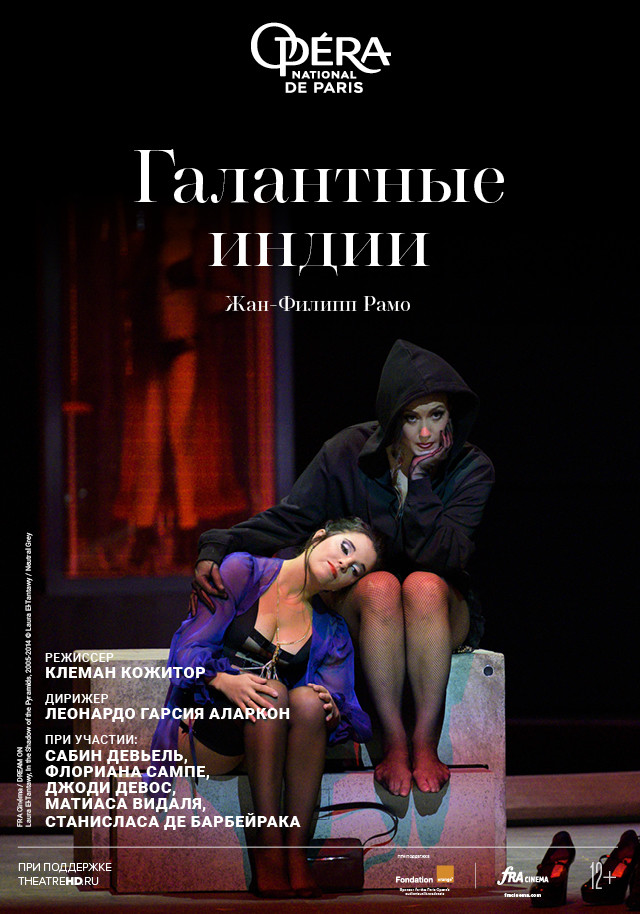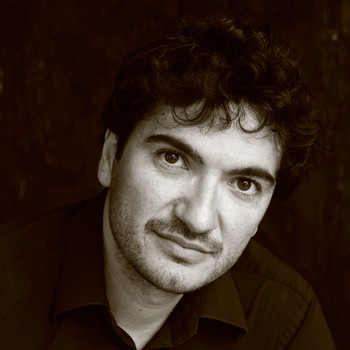
Actors
Bellone, Adario
Valère, Tacmas
Don Carlos, Damon
L'Amour, Zaïre
Crew
Признаемся, что имя Жана-Филиппа Рамо (1683-1764) для большинства любителей музыки – не более, чем строчка из учебника музлитературы. Мы знаем о Рамо и другом великом французском композиторе того времени, Франсуа Куперене, как о важных фигурах в истории искусства, но почему-то музыка их итальянских или немецких современников Вивальди, Баха или Генделя нам куда более знакома. Поэтому парижская постановка 2019 года оперы-балета Рамо 1735 года «Галантные Индии» (иначе его название можно было бы перевести как «Любовь в экзотических странах») – редкая возможность услышать замечательное произведение в тщательно нюансированном исполнении оркестра Cappella Mediterranea и хора Намюра под управлением Леонардо Гарсия Аларкона, с великолепным ансамблем солистов – мастеров барочного пения. Музыка Рамо предстает во всем богатстве красок, от тонкого лиризма до мощного симфонизма – как, например, в сценах шторма на море или извержения вулкана.
Но это отнюдь не концертное исполнение, а яркое действо – масштабный театральный дебют кинорежиссера и видеохудожника Клемана Кожитора. Его соавторами стали хореограф Бинту Дембеле и танцевальная труппа Rualité. Здесь под музыку Рамо танцуют экспрессивный хип-хоп то ли на сегодняшней улице большого города, то ли вне времени и пространства, без жесткой привязки к предписанным либретто Турции, Перу, Персии или индейской Северной Америке. Тем самым благостная просвещенческая идея о благородстве любви «дикарей» в их «приютах наслаждений» в противовес циничной европейской «цивилизации» как бы освобождается от колониального груза прошлого.
Одна из кульминаций спектакля, состоящего из пролога и четырех связанных между собой не сюжетно, но общей идеей, картин, – ария принцессы инков Фани «Viens, Hymen» – о ее любви к испанскому конкистадору. Это настоящий шедевр барочного пения от бесподобной французской сопрано Сабин Девьель – под тонкий аккомпанемент флейты в оркестре и изысканный танец темнокожего танцовщика, который будто импровизирует, то вставая на пуанты в кроссовках, то идя «лунной походкой» Майкла Джексона. Как Рамо, вдохновленный почти 300 лет назад зрелищем танца американских индейцев, создал свое произведение в синтезе культур и цивилизаций, так и Кожитор стирает в своем сложном, изысканном и многоплановом музыкальном зрелище все возможные границы искусств и художественных направлений.
PROLOGUE
The goddess Hebe appears and summons her amiable court to share in her pleasures. The youthful entertainment is interrupted by the arrival of Bellona who invites them all to seek military glory. Some of the youths follow Bellona’s warriors, much to the despair of the others. Hebe, in response, invokes Cupid, whose messengers take flight and disperse far from Europe in the various climes of the Indies.
ENTRÉE 1
The gracious Turk The scene takes place between Osman Pasha, and his slave, the kindly Provençal girl Emilie. As Osman urges her to yield to his desires, Emilie tells him how, in the past, she was abducted by pirates and separated from her true love Valère. A terrible storm brings violent weather. Hearing the cries of the sailors at sea, the ill-fated Emilie is moved. The ships falls victim to the storm. The shipwrecked sailors are enslaved by the Turks. Emilie recognizes her fiancé Valère among the shackled slaves. Osman arrives and Emilie trembles on seeing him, however, the Pasha reassures her and gives her back to Valère.
ENTRÉE 2
The incas of peru Carlos, a Spanish officer, urges his lover Phani, a Peruvian noble, to abandon the cult of the Incas. Phani tells him of her fears about the gathering Incas who are preparing to celebrate the Festival of the Sun on a volcano-capped mountain. Huascar, the Inca leading the ceremonies for the Festival of the Sun, is secretly in love with Phani. He approaches her, intending to invoke the name of the gods to win the heart of the young princess. Phani resists his advances. The Incas gather to attend the Festival of the Sun which is being led by Huascar. Suddenly, the volcano erupts and the horrified crowd flees. Huascar stops Phani and expresses his hopeless love for her. However, Carlos arrives and reveals the truth: it was Huascar who awoke the wrath of the volcano by throwing a rock into its fiery abyss. While the warriors punish the Incas, Phani leaves with Carlos and Huascar rushes headlong into the flames of the awakened volcano.
ENTRÉE 3
The flowers, the persian festival The theatre depicts the gardens of the palace of Ali, the advisor to Tacmas, prince of Persia. Disguised as a merchant woman from the Harem, Tacmas presents himself before Ali, who asks for the reason for the disguise. Tacmas tells him that he is in love with the young Zaïre, Ali’s slave, and that he plans to use the disguise to discover her true feelings. Ali makes it known through an aside that he is in love with Fatima, Tacmas’s slave. Zaïre arrives and strikes up a conversation with Tacmas believing that she is talking to a merchant woman from the Harem. When Tacmas reveals his true identity, Zaïre leaves dumbstruck. Taking her reaction as a sign of aversion, Tacmas feels his jealousy intensify. Just then, Fatima, herself disguised as a Polish slave to sound out Ali’s heart with whom she is in love, appears before Tacmas, who mistakes her for his rival. Ali’s return resolves the situation. The scene ends with the union of the four lovers and the Festival of Flowers.
ENTRÉE 4
The Savages The scene takes place in America. The theatre depicts a wooded glade neighbouring the French and Spanish colonies. Adario, commander of the warriors of the savage nation, is in love with Zima but fears that she will be unable to resist the charms of both Damon and Alvar, officers of the French and Spanish colonies. Alvar and Damon enter. The former swears to win Zima’s heart by his constancy and reproaches Damon for his French fickleness. Zima, daughter of the chief of the savages, appears and responds to Damon and Alvar’s overtures. She tells the Spaniard and the Frenchman that one is too much in love and the other not enough, before declaring her love for Adario. The scene ends with the Ceremony of the Peace Pipe...
The goddess Hebe appears and summons her amiable court to share in her pleasures. The youthful entertainment is interrupted by the arrival of Bellona who invites them all to seek military glory. Some of the youths follow Bellona’s warriors, much to the despair of the others. Hebe, in response, invokes Cupid, whose messengers take flight and disperse far from Europe in the various climes of the Indies.
ENTRÉE 1
The gracious Turk The scene takes place between Osman Pasha, and his slave, the kindly Provençal girl Emilie. As Osman urges her to yield to his desires, Emilie tells him how, in the past, she was abducted by pirates and separated from her true love Valère. A terrible storm brings violent weather. Hearing the cries of the sailors at sea, the ill-fated Emilie is moved. The ships falls victim to the storm. The shipwrecked sailors are enslaved by the Turks. Emilie recognizes her fiancé Valère among the shackled slaves. Osman arrives and Emilie trembles on seeing him, however, the Pasha reassures her and gives her back to Valère.
ENTRÉE 2
The incas of peru Carlos, a Spanish officer, urges his lover Phani, a Peruvian noble, to abandon the cult of the Incas. Phani tells him of her fears about the gathering Incas who are preparing to celebrate the Festival of the Sun on a volcano-capped mountain. Huascar, the Inca leading the ceremonies for the Festival of the Sun, is secretly in love with Phani. He approaches her, intending to invoke the name of the gods to win the heart of the young princess. Phani resists his advances. The Incas gather to attend the Festival of the Sun which is being led by Huascar. Suddenly, the volcano erupts and the horrified crowd flees. Huascar stops Phani and expresses his hopeless love for her. However, Carlos arrives and reveals the truth: it was Huascar who awoke the wrath of the volcano by throwing a rock into its fiery abyss. While the warriors punish the Incas, Phani leaves with Carlos and Huascar rushes headlong into the flames of the awakened volcano.
ENTRÉE 3
The flowers, the persian festival The theatre depicts the gardens of the palace of Ali, the advisor to Tacmas, prince of Persia. Disguised as a merchant woman from the Harem, Tacmas presents himself before Ali, who asks for the reason for the disguise. Tacmas tells him that he is in love with the young Zaïre, Ali’s slave, and that he plans to use the disguise to discover her true feelings. Ali makes it known through an aside that he is in love with Fatima, Tacmas’s slave. Zaïre arrives and strikes up a conversation with Tacmas believing that she is talking to a merchant woman from the Harem. When Tacmas reveals his true identity, Zaïre leaves dumbstruck. Taking her reaction as a sign of aversion, Tacmas feels his jealousy intensify. Just then, Fatima, herself disguised as a Polish slave to sound out Ali’s heart with whom she is in love, appears before Tacmas, who mistakes her for his rival. Ali’s return resolves the situation. The scene ends with the union of the four lovers and the Festival of Flowers.
ENTRÉE 4
The Savages The scene takes place in America. The theatre depicts a wooded glade neighbouring the French and Spanish colonies. Adario, commander of the warriors of the savage nation, is in love with Zima but fears that she will be unable to resist the charms of both Damon and Alvar, officers of the French and Spanish colonies. Alvar and Damon enter. The former swears to win Zima’s heart by his constancy and reproaches Damon for his French fickleness. Zima, daughter of the chief of the savages, appears and responds to Damon and Alvar’s overtures. She tells the Spaniard and the Frenchman that one is too much in love and the other not enough, before declaring her love for Adario. The scene ends with the Ceremony of the Peace Pipe...





.jpg)
.jpg)
.jpg)
.jpg)
.jpg)
.jpg)
.jpg)
.jpg)
.jpg)
.jpg)